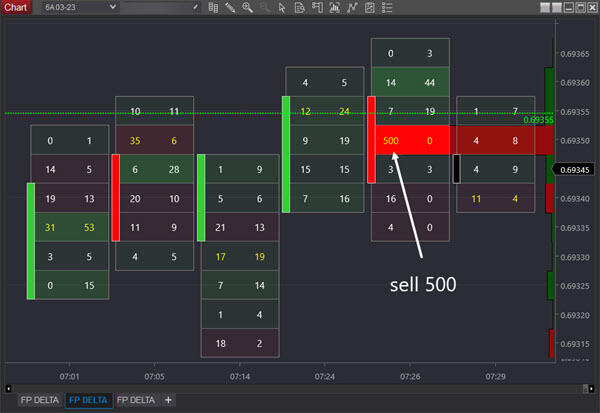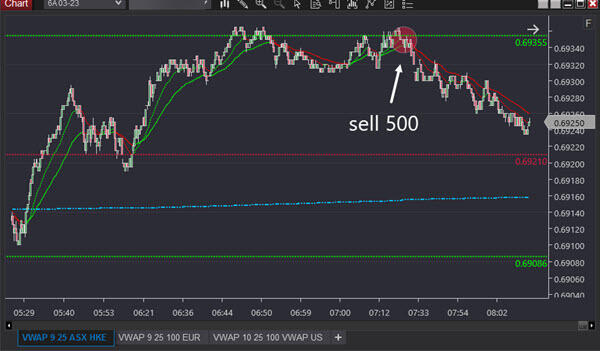Do you like the idea of trading intraday, but you're worried it gets too fast? Are you concerned you'll suffer wild swings in profits but also losses as a consequence?
Listen: I'm not fast thinking. And I'm not someone who can problem-solve quickly. So, how do I trade rapid price moves? You'll see how with examples shortly.
Three transferrable skills to enable you to trade rapid price movement
First: The playing field
Think of a playing field in sports. When the price is within the field of play, you can trade; out-of-bounds is when you don't. And determining the playing field "dimensions" makes up the lion's share of your trading 'game plan'.
Imagine for a moment you are watching the live market trading. At times, it appears like a wild roller coaster of movements up and down in price, right? But the playing field brings order to the chaos. It tells you, "hey don't trade between these prices," or "If you are in a long trade, and the price reaches XYZ, exit the trade".
Your playing field tells you the price ranges you can trade (within the playing field) and the ranges you can't trade (out of bounds). Not only does this framework bring order and structure to your trading day, it massively reduces the mental overload of trying to keep focused on every "wiggle" in price as if hanging on every word of a compelling speech.
Second: The specialist's catalyst
Markets don't move because you identified a "pattern" or "set-up". Price responds to events like employment data, retail sales, central bank announcements etc. These are examples of catalysts for moves in price.
In the days of the trading pits, specialists were traders focusing on a single instrument. It's still the common practice amongst professional traders in today's screen-based trading.
You can liken a specialist to reading each chapter in a novel. As you read through a book, you are "getting to know" each character. In the same way, this happens with specializing. Because you know the background story, you see the story unfolding as you had intuitively expected. When you hear or read professional traders talking about trading using "feel" or "intuition", they are referring to this.
In the example coming shortly, the "feel" for the market moving down is the observation and subsequent documentation two days earlier.
Third: The playbook
A playbook is a catalogue of trades that:
-
Have a proven edge - i.e. they produce positive results (without harsh drawdowns) over any meaningful sample size.
-
They are based on multiple evidence characteristics, making them unique and easily distinguishable. A feature of the playbook trades I share with clients is the tiny movement in price to suggest the trade is not working, and therefore a paper-cut loss or scratch trade is the extent of the worst-case outcome.
Time for the example
The brief video is from live trading mentoring featuring the concepts in a practical setting so clients can replicate what I'm doing.
You'll notice that at one point, the fast movement reaches a pace I can't compete in.
But isn't the point here to demonstrate rapid trading moves?!!
Have you ever driven your car at 200 miles or kilometres per hour? 140km an hour is the fastest I have driven for any reasonable period. Any quicker, I was sure I couldn't control the car. Yet 140 is still fast, right? And it's the same with trading - there is fast, and there is faster! But the skills above make it obvious when you stand aside.
PS: I mentioned knowing where to 'no longer hold a long trade' based on the playing field. The different 'boundaries' align with where professionals and market makers trade/don't trade. Remember the playing field from the video?
Below are screenshots featuring the same playing field levels 17 hours after the trade was recorded. Colour-coded boundaries notify you of the differing approach to exiting a position. In this instance, "green" signals the weakest of the boundaries. They can be pushed "out" a little further.
See the professional trader who tested this out? A 500-lot trade (50 million face value) is exited only after waiting to see if the market can push the boundaries. When it's clear it won't, the professional sells the position.

Forex and derivatives trading is a highly competitive and often extremely fast-paced environment. It only rewards individuals who attain the required level of skill and expertise to compete. Past performance is not indicative of future results. There is a substantial risk of loss to unskilled and inexperienced players. The high degree of leverage can work against you as well as for you. Before deciding to trade any such leveraged products you should carefully consider your investment objectives, level of experience, and risk appetite. The possibility exists that you could sustain a loss of some or all of your initial investment and therefore you should not invest money that you cannot afford to lose. You should be aware of all the risks associated with trading on margin, and seek advice from an independent
Editors’ Picks

EUR/USD eases toward 1.1700 as USD recovers
EUR/USD stays on the back foot and declines toward 1.1700 on Friday. The pair faces headwinds from a renewed uptick in the US Dollar as investors look past softer US inflation data. However, the EUR/USD downside appears capped by expectations of the Fed-ECB monetary policy divergence.

USD/JPY rallies to near 157.00 as Yen plunges after BoJ’s policy outcome
The USD/JPY is up 0.85% to near 156.90 during the European trading session. The pair surges as the Japanese Yen underperforms across the board, following the Bank of Japan monetary policy announcement. In the policy meeting, the BoJ raised interest rates by 25 bps to 0.75%, as expected, the highest level seen in three decades.

Gold stays weak below $4,350 as USD bulls shrug off softer US CPI
Gold holds the previous day's late pullback from the vicinity of the record high and stays in the red below $4,350 in the European session on Friday. The US CPI report released on Thursday pointed to cooling inflationary pressures, but the US Dollar seems resilient amid a fresh bout of short-covering.

Bitcoin, Ethereum and Ripple correction slide as BoJ rate decision weighs on sentiment
Bitcoin, Ethereum, and Ripple are extending their correction phases after losing nearly 3%, 8%, and 10%, respectively, through Friday. The pullback phase is further strengthened as the upcoming Bank of Japan’s rate decision on Friday weighs on risk sentiment, with BTC breaking key support, ETH deepening weekly losses, and XRP sliding to multi-month lows.

How much can one month of soft inflation change the Fed’s mind?
One month of softer inflation data is rarely enough to shift Federal Reserve policy on its own, but in a market highly sensitive to every data point, even a single reading can reshape expectations. November’s inflation report offered a welcome sign of cooling price pressures.
RECOMMENDED LESSONS
Making money in forex is easy if you know how the bankers trade!
I’m often mystified in my educational forex articles why so many traders struggle to make consistent money out of forex trading. The answer has more to do with what they don’t know than what they do know. After working in investment banks for 20 years many of which were as a Chief trader its second knowledge how to extract cash out of the market.
5 Forex News Events You Need To Know
In the fast moving world of currency markets where huge moves can seemingly come from nowhere, it is extremely important for new traders to learn about the various economic indicators and forex news events and releases that shape the markets. Indeed, quickly getting a handle on which data to look out for, what it means, and how to trade it can see new traders quickly become far more profitable and sets up the road to long term success.
Top 10 Chart Patterns Every Trader Should Know
Chart patterns are one of the most effective trading tools for a trader. They are pure price-action, and form on the basis of underlying buying and selling pressure. Chart patterns have a proven track-record, and traders use them to identify continuation or reversal signals, to open positions and identify price targets.
7 Ways to Avoid Forex Scams
The forex industry is recently seeing more and more scams. Here are 7 ways to avoid losing your money in such scams: Forex scams are becoming frequent. Michael Greenberg reports on luxurious expenses, including a submarine bought from the money taken from forex traders. Here’s another report of a forex fraud. So, how can we avoid falling in such forex scams?
What Are the 10 Fatal Mistakes Traders Make
Trading is exciting. Trading is hard. Trading is extremely hard. Some say that it takes more than 10,000 hours to master. Others believe that trading is the way to quick riches. They might be both wrong. What is important to know that no matter how experienced you are, mistakes will be part of the trading process.
The challenge: Timing the market and trader psychology
Successful trading often comes down to timing – entering and exiting trades at the right moments. Yet timing the market is notoriously difficult, largely because human psychology can derail even the best plans. Two powerful emotions in particular – fear and greed – tend to drive trading decisions off course.

